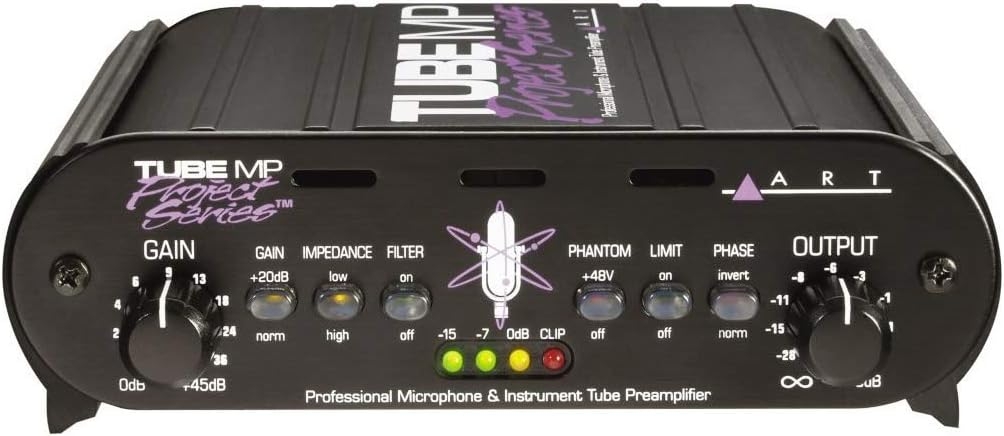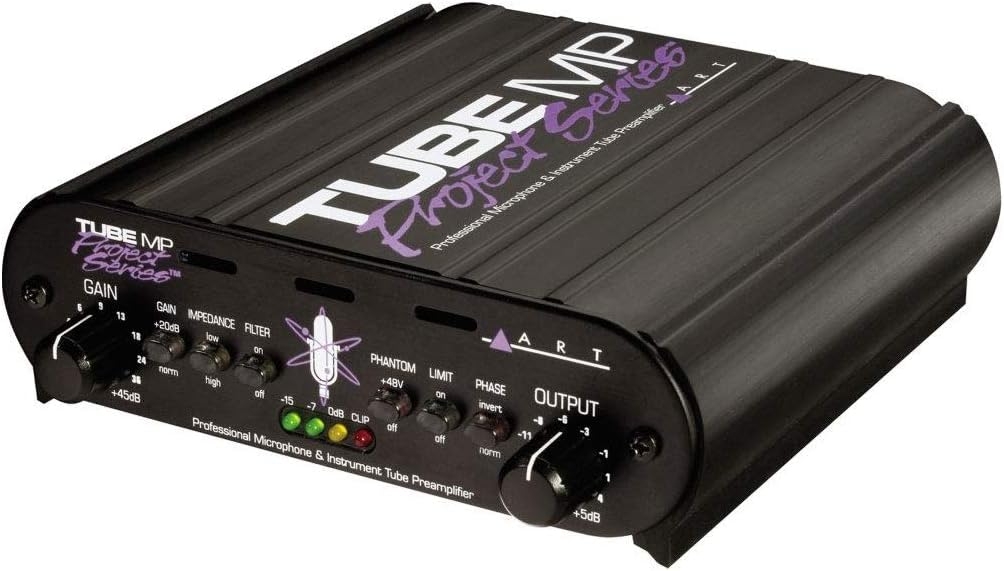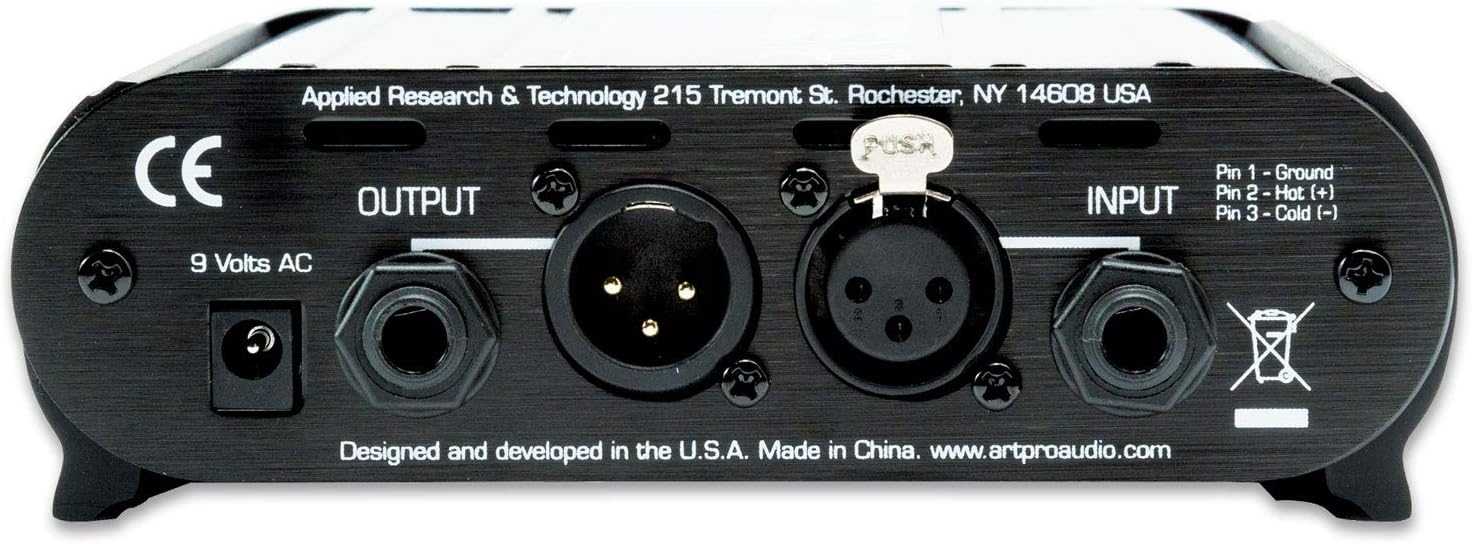The ART Tube MP Project Series is a budget-friendly preamp that promises to enhance your audio experience. In this review, we’ll break down its pros and cons, performance, features, and why it’s worth considering for your setup.
Pros
- Affordable: With a modest price tag, the ART Tube MP Project Series offers excellent value for money.
- Sound Enhancement: It adds warmth and depth to your audio recordings, making them sound professional.
- Easy to Use: User-friendly controls make it ideal for beginners and experts alike.
- Versatile: Works with a wide range of instruments and microphones.
- Solid Build: Sturdy construction ensures durability.
- Compact Design: Its small size makes it easy to fit into any studio setup.
- Phantom Power: Supports condenser microphones, expanding your recording options.
- LED Metering: Accurate level monitoring helps prevent clipping.
- Rugged Power Supply: Included for added convenience.
Cons
- Limited Features: Lacks advanced options for more seasoned users.
- Slight Hiss: Some users report a minimal noise level, but it’s generally not noticeable in recordings.
- External Power Supply: Some may prefer an internal power source for added portability.
- No Rack-Mount Option: Not suitable for rack-mounted setups.
- XLR Cable Not Included: You’ll need to purchase an XLR cable separately.
- No USB Connectivity: Lacks direct USB connection for digital recording.
Performance
The ART Tube MP Project Series impresses with its performance. It’s capable of enhancing the audio quality of your recordings, adding warmth and character that’s often missing in digital audio. Whether you’re recording vocals, acoustic instruments, or electric guitars, this preamp can make your sound come to life.
Its LED metering ensures you’re always in control of your levels, preventing unwanted clipping. The inclusion of phantom power allows you to use condenser microphones, expanding your recording options.
The slight hiss reported by some users is a minor drawback, but it’s usually only noticeable in very quiet recording environments. In most cases, it won’t be a significant issue.
Features
While the ART Tube MP Project Series may not have the most extensive feature set, it offers essential functionality that gets the job done without overwhelming beginners. It’s a straightforward preamp designed for users who want simplicity and quality.
Its compact design and sturdy build make it a reliable addition to any studio setup. The inclusion of an external power supply might not suit everyone, but it’s a minor inconvenience for the price point.
Conclusion
In conclusion, the ART Tube MP Project Series is a fantastic budget-friendly preamp that delivers exceptional value. It may lack some advanced features, but it excels in enhancing the audio quality of your recordings. Whether you’re a beginner or a seasoned musician, this preamp is a worthy addition to your setup, offering affordability, versatility, and ease of use.





David Russell –
The price of this preamp was in the range that the band could afford and it lives up to that price range. We didn’t expect it to sound like a thousand dollar mic-preamp thus we are really happy with it. I needed a mic-preamp that had phase reverse on it and this does the trick. I play in the band but am also the sound guy and the compressor on this comes in really handy when a guest singer comes up as I can hit the button and not worry so much about the output signal being overloaded. It’s made my life easier setting up sound and I will start using it for recording in a few weeks when we start working on a new demo for the band. I think the trick with this preamp is to keep the input at the right place and then one can turn up the output to where they need it. I have to say it drives me nuts when reviewers will say something along the lines of “it’s not a pro mic-preamp”, well no, at this price would one really think it is? I mean those of us that can only afford so much, need it right away and can work with it to make it sound the best it can are really happy with it. In my musical life I have worked with excellent top of the line gear and worked with really bad gear, one can get decent sound out of just about anything if you work at it.
james muckleroy –
Haven’t used it much but they always served me well , justSeems better than other tb mp with silly settings … has better features … not as nice as pro MPa but I respect their geAr and it’s affordable … on a budget it’s a clear choice
Gnobuddy –
This is a nice little mic preamp with a couple of vacuum tube stages in it. Works well with microphones and acoustic-electric guitars, as well as with electric guitars and electric bass guitars.Features are limited; the gain and output level are adjustable, there’s a switchable low-pass filter to cut out rumble and wind noises from the mic, phantom power for condenser mics is available, and there’s a crude limiter available if you must have one. Like any good pre-amp, it has virtually no sound of its own, but lets the sound of the source come through cleanly. Push it to clipping and you may just hear a tiny hint of tube distortion (“warmth”).I dislike two things about this Art Tube MP: it has no on-off switch, and it’s powered by an ugly, annoying, space-eating wall wart that hogs two or three spaces on your power strip.Nothing too wrong with this Tube MP, but I prefer a competing product by the same company (ART): the ART Tube PAC. The Tube PAC is essentially the Tube MP plus a compressor in one box. Not only does the compressor make the Tube PAC much more versatile than the Tube MP, especially in live situations, but the Tube PAC also has an on-off switch and an internal power supply (no wall-wart). The Tube PAC is perfect for use both with my bass guitar and with my wife’s vocals. The compressor, used subtly, is invaluable in both applications.My suggestion: skip the Tube MP and get the Tube PAC if you can afford the $50 price difference. They sound the same, but with the PAC you have a compressor available when you need it.-Gnobuddy
David H. Hanneman –
I can’t really say this is great or fantastic but it did help alleviate some audio issues that I had before buying this. One thing I wish this did come with was an on/off switch though – instead I ended up unplugging the transformer cord. It does a good job of amplifying my microphones signal before I pass it into the computer for mixing. You can adjust the volume to a nice comfortable level without getting the distortion or noise hums that you might get from simply cranking the volume in your computer’s mixer. The filter seems to eliminate a bit of the background noise from my air conditioner and computer fan, and the limiter does a decent job of keeping loud noises from distorting. I am not an audiophile or studio expert by any means, but for me, this pre-amp is a cheap no-brainer solution to help my Behringer microphone provide a good quality audio stream for voice-overs. There is a big difference between before I put it inline with my microphone and afterwards.
Big Man Tiny Kingdom –
Really impressed with this little guy. I own a Shure SM7B mic and in my studio it is powered by a DBX 286s preamp. I am doing more and more mobile recordings and wanted a more smaller setup to pack for the road, and the DBX 286s is a rack mount unit. I was shocked at the power of this small size ART preamp, but I do match it up with a Triton Fethead to give me more than enough gain for the SM7B mic. Let me tell you… this smaller combination (the ART preamp plus the Triton Fethead) sounds better than the DBX 286s, and it sounds like it provides cleaner output (is less noisy than the DBX 286s), and I do not have to crank up the gain as much as I have to with the DBX. I loved it so much that I bought a 2nd one as a backup because the price is just perfect for what you get from this unit.
David G. Beneke –
You do get your moneys worth out of this amp with features and so on. The plus 20db gain switch works very well and the high/low impedance switch is a very good feature, adding gain to ribbon and dynamic mics. However The high pass filter really does very little and the limiter is weak. The overall sound quality is not bad, I think it could be improved with a better tube, which I am going to install sometime soon. Just a notch down from being a professional sounding amp, but for $59.00, what do you expect?Addendum: Adding a Mullard Master Valve tube from the Tube Depot which was picked for High Gain Balance and Low Noise Microphonics makes this amp sound a hundred percent better. Good idea to clean the circuit board with De-Oxit to get rid of the tons of excess flux on the solder joints, this also helps with the amps noise. Plugging it into a great Pre/DA converter will like my Focusrite Forte, helps get a clean signal to the computer as well.
javier –
diferente resultado entre bajo y guitarra y micrófono para guitarra eléctricaMuy interesante el “sabor” que agrega a una guitarra conectada directa y amplificada con un amplificador de estado solido (tengo 4 amplificadores de bulbos, marshall, vox y fender) y si senota un efecto parecido al menos o mejor al de un marshall hibrido AVT que tengo, creo que el preamplificador ofrece un overdrive muy deseable a la guitarra, en el bajo es menos notorio el efecto, sin embargo si tiene un efecto positivo, lo comparamos contra el overdrive de un amplificador Fender rumble 150, el amplificador fender tiene mejor sonido, sin embargo si se tiene un amplificador de estado solido que no tenga una gran calidad de sonido para el overdrive del bajo o no tenga overdrive, si se podrían obtener “buenos” resultados; como caja directa para el bajo, lo he probado con un par de grabaciones de rock classico y el resultado es bueno, mejor que no contar con el preamplificador; con micrófonos, solo lo he utilizado para microfono para grabar bocinas (4×12 celestion,1x12celestion, 1×12 eminence y 4×10 jensen, mezclasde alnico y ceramicas) de amplificadores de guitarra eléctrica ya que el volumen al que puedo tocar es bajo (casa) y el resultado en las grabaciones realizadas son satisfactorios, no le agrego mucha ganancia, solo la necesaria para no tener la grabadora digital con la ganancia al máximoy ajustar mas basado en el output para no agregar mucha coloración a lo que ya se obtiene con los amplificadores de bulbos con atenuador para el volumen.Creo que el resultado para un micrófono de voz debiera ser satisfactorio y si debe ser notoria la coloración que agrega.Los micrófonos utilizados son un SM57, un Sennheiser 409 y un radio shack (sorprendentemente tiene una buena calidad de sonido)Silo recomiendo y estoy evaluando la versión V3 de dos canales para agregar algo de variedad de sonidosEspero sean utilices mis comentarios